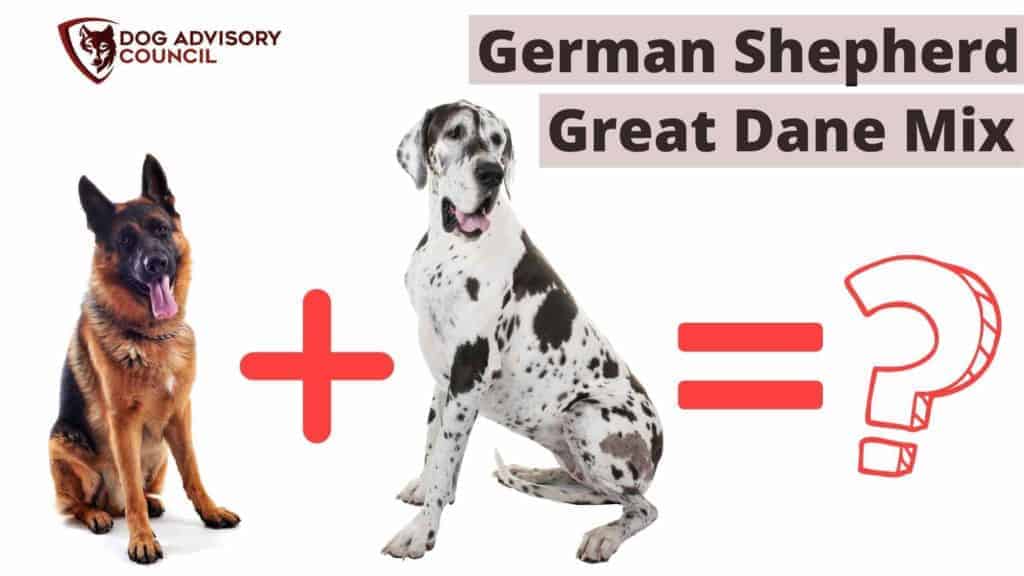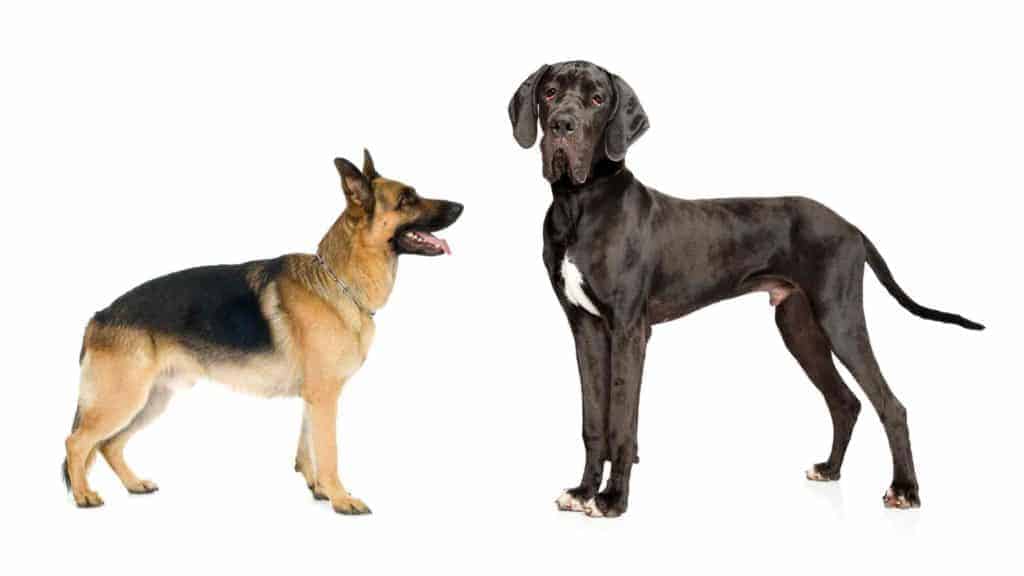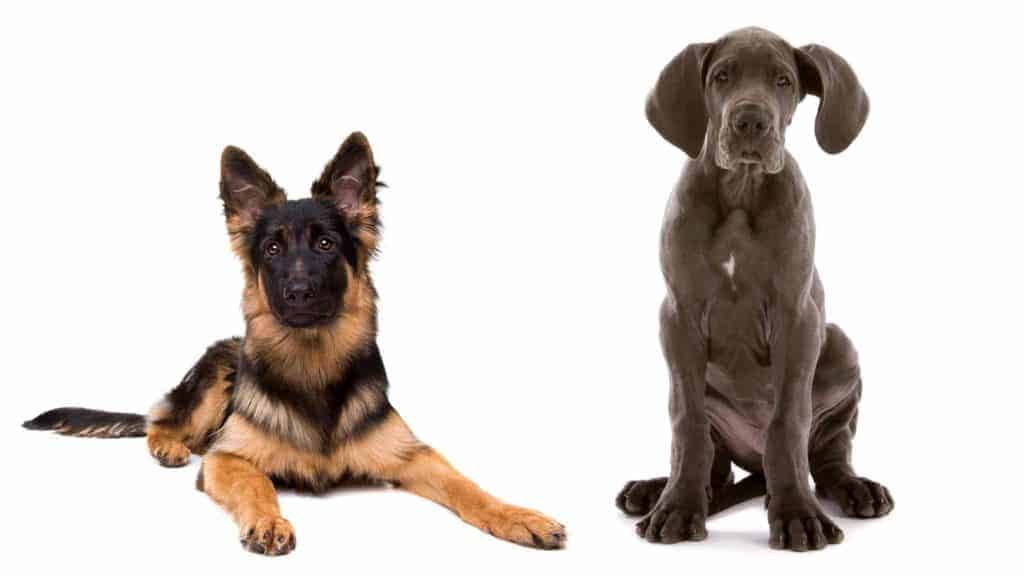
If you’ve ever seen a photo of a German Shepherd Great Dane, you know that these are impressive and majestic, large dogs.
Curious to know more? Read on below for all of the exciting details!
The German Shepherd Great Dane is one of the largest cross-breed dogs in the world, coming in around 28-30 inches (71-76 cm) for height and weighing around 65-120 pounds (29-54 kg).
They can look like either their German Shepherd or Great Dane parent, in color, and take on their best traits, like being protective, friendly, and gentle. Below is all you want to know about this giant dog breed!
What is a German Shepherd Great Dane Mix called?
Sometimes the name is the best part! The adopted mash-up name for this mixed breed is a Dane Shepherd in most dog lover circles.
What does a German Shepherd Great Dane Mix look like?
As with most mash-up puppies, it really depends on what genes are strongest when you pick your puppy out of a litter.
From one to the other, though, most will have large bat-style ears and a long snout. Both of these are common features in both parent breeds, so it’s common to see in puppies as well.
While they will seem oversized at first, they will grow into their features (for the most part).
These can come in a series of colors and fur patterns depending on their parent breed colors and the strongest genes.
These include:
- Black
- Brown
- Blue
- Brindle
- Fawn
- Harlequin
Some will have classic German Shepherd markings around their face and legs, and others won’t, taking their Great Dane genetics on a bit more with the speckling. This is a massive part of the fun in enjoying mix breed puppies, though — not knowing what you’re going to get.
They tend to have short fur, though some may have a bit of a medium fur length thanks to the Shepherd in them. They tend to be pretty low maintenance for grooming, though their fur will still need attention (more on that in a bit).
Since both parent breeds are muscular and strong dogs, you can expect your puppy to be as well. This means that when they pull on their leash, they’ve got a lot of muscle to back them up.
As we’ll talk about more, later on, training will be important for staying in control of your dog!
How big will a German Shepherd Great Dane Mix get?
This is the impressive part. As mentioned, they are the biggest known cross-breed dog in the world (recognized, that is). They often will be between 28-30 inches (71-76 cm) in height and weigh between 65-120 pounds.
If their Great Dane genes tend to be especially strong, it’s not uncommon for them to be larger and heavier, though!
There is no way that they can ever be called small dogs! They’re not even large dogs, technically. They’re considered giant dogs.
What is the lifespan of a German Shepherd Great Dane mix?
It’s common in the dog world for larger dogs not to live as long as medium or small dogs, and this definitely is the case here.
These guys live to be about 7-10 years at the most. While some can live longer, their health declines rapidly, and many owners will be stuck facing that hard decision all too quickly.
The lifespan itself, or its shortness, is something to think about seriously since it can be challenging when bringing this dog into the family where you have young children. Keep reading for more information on that!
What is the temperament of a German Shepherd Great Dane mix?
Earning the nickname “gentle giants,” these dogs are wonderful for their personalities and temperaments. They are strong and courageous like a German Shepherd. They are kind and goofy and affectionate like Great Danes.
The mix of both breeds makes them loyal and protective and great for when you want a dog that will watch over your kids and other household pets.
Natural protectors and guardians of their favorite people will happily keep watch over children when they are playing and otherwise exploring. They also can make great protectors since they do naturally defend and protect against strangers or unknown animals.
Intelligent, loyal and attentive, these dogs train really well and aren’t known for being stubborn. As long as you focus on basic training and socialization, your dog will respond willingly to you and will do whatever it can to make you happy. Cute, right?
Another temperament issue to think about, depending on your family situation and the home itself, is that these are high-energy dogs. They like to move a lot, and their large size means that they often knock things over along the way.

Are German Shepherd Great Danes good family dogs?
Their large size often leads many people to fear them around children, but they are great family dogs! They love kids and love to be around them as much as possible. They like being “a member of the crew” when watching movies or just enjoying a meal together.
They are protective of their family, including their furry siblings, and will be excellent watchdogs and guard dogs. This is more because of the Shepherd in them rather than the Great Dane.
They also make great dogs for training so that everyone can get involved in the training with consistency. Since some dog breeds are stubborn, it’s nice to know that you can enjoy some ease with this one, especially since it’s so big.
Main Dane Shepherd health issues to know about
Pretty much all of the Dane Shepherd’s potential health issues will have to do with their size. Giant dog breeds will have their own problems by their sheer size alone. These and their breed-specific ones are below:
- Hip dysplasia
- Bloat
- Skin concerns
- Ear infections
- Dental problems
- Allergies
Hip dysplasia
Notoriously known as a “big dog problem,” this condition can happen at the hip or the elbow. A Dane Shepherd will most likely have the issue in their hips. The joint and the bone don’t fit together as they should.
This can “present” at any age and is common in these giant dogs somewhere between ages 5-7 and onward. It’s often thought of as a form of arthritis, though it tends to start earlier and causes more intense pain much faster.
You can manage it with pain medication and massage once it gets severe. Some vets offer surgery, but it is a very specialized practice, and it isn’t always recommended for larger dogs since the recovery can be intense.
Bloat
Most dog owners will know that this is a potentially severe complication for dogs. The stomach twists and causes a blockage in the organ itself. Gasses and chemicals build-up, swelling the dog’s stomach, which can lead to lung issues and heart problems if the blood flow becomes compromised. This can be fatal if not treated!
Skin concerns
More from the Great Dane side of the family, sensitive skin and general skin irritation can be common in these giant dogs.
You’ll need to keep an eye for bacteria, flaking, and other signs that something will start as far as skin issues. Grooming at the right frequency and with the right products will help a lot with this!
Ear infections
Thanks to their large ears, infections can be common as well. You’ll want to keep cleaning their ears regularly with wipes or cotton balls. Even if you do this several times a week, infections are still common!
Dental problems
Just like any dog, they can be prone to dental issues. You’ll want to consider something like specialized food, toys, and more to help them enjoy a better quality of life as far as their teeth are concerned.
Since dental problems can often lead to more significant health problems, you’ll want to keep this in mind as something to prioritize seriously.
Allergies
Allergies are common in these breeds as well, so this means that your Dane Shepherd can have allergy problems. Your breeder is going to be able to give you an entire allergy history from both parents, and you’ll definitely want to consider getting your dog a test, too, since allergies can be severe in dogs.
How to take care of a Dane Shepherd
A lot of dogs have a lot of focus on grooming and shedding seasons. You’ll be happy to learn, then, that taking care of a German Shepherd Great Dane mix is going to be relatively easy from that point of view.
Since they don’t shed very much, you’ll need to groom them over once or twice a week. You’ll want to use a vet-recommended brush, though, since they do have sensitive skin.
You’ll want to avoid bathing them regularly since it can actually worsen their fragile skin. Most experts will recommend something like every 3 months and that you should take them to a groomer. They’ll have the experience and the products to know how to help bathe your dog and still keep their skin in good health.
One of the main features to focus on for your Great Dane is the food they get. Since they are prone to joint and bone issues, you’ll need a giant dog breed food, which will be loaded with extra protein and omega-3s to help with this.
Your breeder or vet will be able to help you find the right one for your needs. This is also really helpful if your dog does have allergies that you’re looking to avoid.
Their size also means that exercise will be a little bit tricky. Firstly, this mix breed requires a lot of it since they are so prone to being hyperactive. This is primarily the German Shepherd genes in them.
They will require walks, playtime, and more. However, exercise can also be a trigger for “big dog problems,” including hip dysplasia, since their larger joints are already going to be compromised with the larger size.
Your vet and other specialists will be able to suggest exercise options that will be helpful when looking to give them an activity that protects their joints. This is important from puppyhood right up to senior living.
Lastly, the concept of socialization. Since their German Shepherd genes can make them protective, they’ll need to be socialized with new people, other animals, new environments, and more very young.
The more they see and experience, the better they will adapt to new situations and people without necessarily seeing them as threats.

How much does a German Shepherd Great Dane mix cost?
While tricky to breed in some places and not quite as popular as other breeds, a German Shepherd Great Dane mix is priced affordably at approximately $1 000 per puppy.
If you want to save costs, you can look at rescuing one from a shelter since these dogs are commonly cast-offs when families realize just how big they are going to get and how much food they eat. This is, sadly, a common find. These will cost around $500.
Pros and cons of a German Shepherd Great Dane mix
Intriguing dogs with a unique blend of genes, a Dane Shepherd is going to have some ups and downs to consider before you add one to your family. The closer you consider them, the better since a dog should be a lifelong commitment! Here they are:
PROS
- Great watchdogs
- Low maintenance in health and grooming etc
- Great family dogs
While they are large dogs and can be a little clumsy at times, they are affectionate, loyal, and friendly. This makes them a quintessential family dog for all of the right reasons.
The low maintenance is excellent when you specifically are searching for a breed that will be primarily easy-going on the brushing and bathing.
CONS
- It takes them a while to warm up to new people
- Need a lot of space
- Exercise is a must
- Short lifespan
The German Shepherd genes in them make it challenging for them to warm up to new people or animals. This is a huge part of why socialization is essential.
While protectiveness is reassuring, you want to make sure that they react to the right triggers rather than the harmless ones. You’ll also want to prioritize obedience commands so that you can reign in their behavior if they start to act in a way that you don’t want.
They do need a lot of space to live simply because they are large dogs. They also will need a lot of exercises to keep themselves happy since they can get restless and hyperactive if they don’t get the training they need.
Since their life span is short compared to many dogs, it is something to think about if you have especially young children who will struggle with their dog passing away while they are so young. It isn’t a dealbreaker, of course, but it definitely will be something to think about.
Make them part of the family
Many people will take on a Great Dane or a Dane Shepherd and then realize that they don’t want one after all. The reasons often include their sheer size, the amount of money they have to pay for food and upkeep, and more.
Mentioned briefly, it bears repeating here: bringing home these sweet and good-natured dogs should be a commitment that you think about seriously because they are common additions to shelters when they are just a few years old.
This is part of why breeders are so specific in their adoption applications. They want to know that the family understands just what possible complications lie waiting in the future so that families walk into the situation with their eyes wide open.
Since they are so loving and loyal, it’s distressing to the dog, and it also can be challenging for shelters to rehome them since they have such specific needs.
These pros and cons will help you understand whether or not this mixed breed will be right for you.
In short
Large, loyal, and fun, a German Shepherd Great Dane mix is a giant dog breed that often measures 28-30 inches (71-76 cm) for height and weighs around 65-120 pounds (29-54 kg).
They can be prone to health concerns and need specific socialization training to help them stay healthy and happy.
They are commonly given away to shelters, so proper knowledge and understanding of this breed’s needs are vital.
A German Shepherd Great Dane is a large, affectionate, and hyperactive giant dog that will be an excellent choice for the active family.
While they can be costly pets and don’t live quite as long as many would like, they are great to consider!
If you know someone who’s looking for a larger-than-life dog, share this with them!
